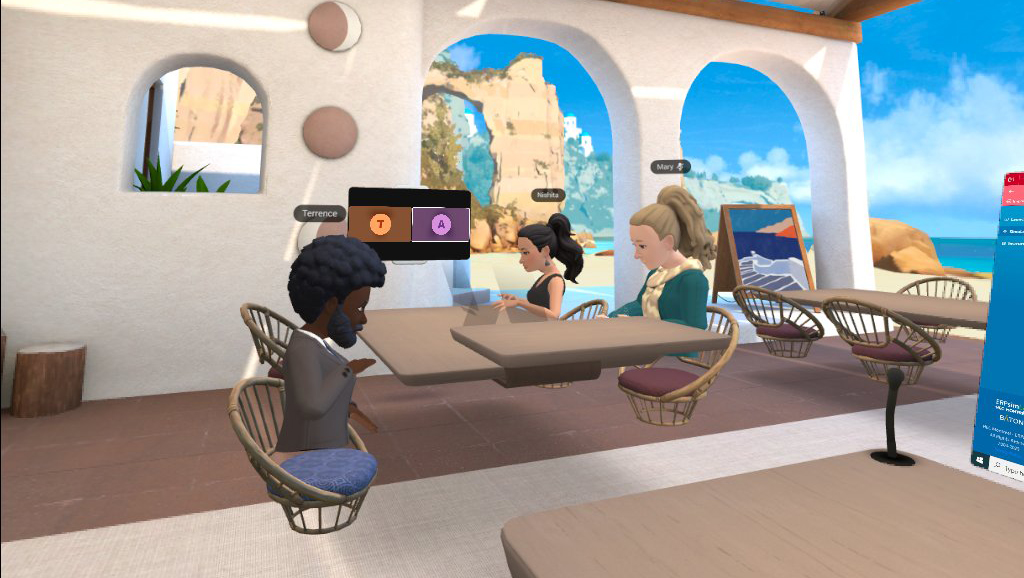Last fall, Lerner College graduate business students had an out-of-body experience in their Enterprise Resource Planning class — one that came with a peaceful Mediterranean-style view.
Students from the University of Delaware weren’t actually disembodied, but participating in an end-of-semester competition alongside students from Penn State University, using virtual reality headsets and Meta’s Horizon Workrooms.
The teams of students competed in a simulation game to help them grasp the concepts of an enterprise system for running a company. But at the same time, they were also able to engage with students at other locations, whether that was remotely from their homes or even other states.
With people working more and more from home, elements to this virtual reality technology could someday change how we learn and work.
Companies around the world use enterprise resource planning (ERP) systems. They are “massive systems that run every aspect of a company. So they run sales, and marketing, they run all the production, supply chain, HR, and all the accounting is done automatically,” said Ellen Monk, an associate professor of management information systems (MIS) at UD’s Alfred Lerner College of Business and Economics. Monk organized the competitions.
One of the largest companies that creates these systems is SAP. This simulation game allows students to use SAP’s software to handle a fictional company selling boxes of cereal in different parts of Germany. The students are scored on how well they manage the firm’s processes and how the company performs as a result.
“It’s hard for students to grasp the concepts of an enterprise system in a vacuum,” Monk said. “In the simulation game, they have access to a live SAP system. This gives them experience using the software and running a small company without the risk of losing real money.”
In past years, students would play this game on their computers without sharing a virtual workspace. But the game comes to life once the students put on their VR headsets.
Monk heard about the VR option from a friend at Penn State who was trying it out on hybrid classes, and she was intrigued. She has researched how remote learning compares to a face-to-face experience, and was interested in whether VR could help bridge that gap for students.
Monk is still reviewing data from the sessions, but the students initially reported a better, more immersive connection than what they experienced meeting remotely.
“VR is never going to replace face-to-face, but it is interesting,” said Monk, who sees potential applications for overseas work as well. Students preparing to study abroad, for example, could connect with colleagues at their internships before ever traveling. Companies can collaborate more effectively with workers scattered around the globe when travel is not practical.
Nishita Challa, who is finishing up a master’s in business analytics and information management, took part in multiple SAP competition sessions, some with Penn State students and others with UD students alone.
She called it a very good alternative for remote learning. “It does give you a different experience and a different feeling (than a video call).”
In the virtual space, you can see everyone who is participating, split into groups, and move around the room, she said. “You can meet them, you can speak to them … it’s as if you’re just in one room together, so that really did make a difference.”
Participants create an avatar and can use their laptops along with the headsets. The professor has the option to display information for the whole group on a screen, if needed, just as with an in-person whiteboard.
“Just like Zoom, but more interactive,” is how Terrence Chin-Young described the experience. Chin-Young is enrolled in the dual MBA and master’s in business analytics and information management program and works for JPMorgan Chase in product management.
On video calls, people often turn off their cameras and fade into the background, apparently present but possibly staring at the ceiling, taking a nap, or frying an omelet in another room. That won’t fly in the virtual reality experience. “It kind of forces you to have to interact,” Chin-Young said.
Virtual reality still has some hangups, participants reported. In addition to the cost and compatibility issues, the headsets can get uncomfortable after about half an hour. And, as with all technology, there can be glitches.
“I would definitely say that it was challenging to focus after a certain period,” Challa said. “… I don’t think we’re there yet when it comes to technology.”
Like Monk, Chin-Young doesn’t see in-person interaction going away anytime soon. He mentioned the limited nature of the avatars. Someday they might be a holographic copy of a person, which would be a game changer, he said, “but until we get to that point, I think people are still going to want to have that face-to-face, because you can actually see my mouth moving rather than some, like, Muppet-type creature.”
“It was really interesting. And we learned a lot,” Challa said.
Monk wants to experiment with the technology more.




